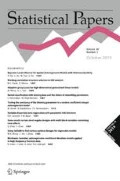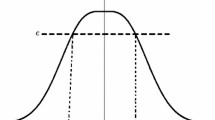Abstract
In the present paper we are going to extend the likelihood ratio test to the case in which the available experimental information involves fuzzy imprecision (more precisely, the observable events associated with the random experiment concerning the test may be characterized as fuzzy subsets of the sample space, as intended by Zadeh, 1965). In addition, we will approximate the immediate intractable extension, which is based on Zadeh’s probabilistic definition, by using the minimum inaccuracy principle of estimation from fuzzy data, that has been introduced in previous papers as an operative extension of the maximum likelihood method.
Similar content being viewed by others
References
Casals, M.R., Gil, M.A. and Gil, P. (1986a). On the use of Zadeh’s Probabilistic Definition for Testing Statistical Hypotheses from Fuzzy Information.Fuzzy Sets and Systems, 20, 175–190.
Casals, M.R., Gil, M.A. and Gil, P. (1986b). The Fuzzy Decision Problem: an approach to the Problem of Testing Statistical Hypotheses with Fuzzy Information.European J. Oper. Res., 27, 371–382.
Chernoff, H. and Lehmann, E.L. (1954). The use of the Maximum Likelihood Estimates in χ2 test for Goodness of Fit.Ann. Math. Stat., 25, 579–586.
Corral, N. and Gil, M.A. (1984a). The Minimum Innaccuracy Fuzzy Estimation: an extension of the Maximum Likelihood Principle.Stochastica, VIII, 63–81.
Cramer, H. (1946).Mathematical Methods of Statistics, Princeton University Press. Princeton.
Fisher, R.A. (1924). The condition under which χ2 measures the discrepancy between observation and hypothesis.J. Royal Statist. Soc. 87, 442–450.
Gil, M.A. (1987a). Fuzziness and Loss of Information in Statistical Problems.IEEE Trans. Systems Man Cybernet., 17, 6, 1016–1025.
Gil, M.A. (1988a). Probabilistic-Possibilistic Approach to some Statistical Problems with Fuzzy Experimental Observations. InCombining Fuzzy Imprecision with Probabilistic Uncertainty in Decision-Making (J. Kacprzyk and M. Fedrizzi, Eds.). Springer-Verlag, Berlin, (accepted for publication).
Gil, M.A. and Corral, N. (1987b). The Minimum Inaccuracy Principle in Estimating Population Parameters from Grouped Data.Kybernetes, 16, 43–49.
Gil, M.A., Corral, N. and Gil, P. (1985a). The Fuzzy Decision Problem: an approach to the Point Estimation Problem with Fuzzy Information.European J. Oper. Res. 22, 26–34.
Gil, M.A., Corral, N. and Gil, P. (1988b). The Minimum Inaccuracy Estimates in χ2 tests for Goodness of Fit with fuzzy observations.J. Statist. Plan. Inf., 18 (accepted for publication).
Gil, M.A., López, M.T. and Gil, P. (1984b). Comparison between Fuzzy Information Systems.Kybernetes, 13, 245–251.
Gil, M.A., López, M.T. and Gil, P. (1985b). Quantity of Information; Comparison between Information Systems: 1. Nonfuzzy States, 2. Fuzzy States.Fuzzy Sets and Systems, 15, 65–78, 129–145.
Kerridge, D.F. (1961). Inaccuracy and Inference.J. Royal Stat. Soc., Ser. B, 23, 184–194.
Mathai, A.M. and Rathie, P.N. (1975).Basic Concepts in Information Theory and Statistics. Wiley Eastern Lim. New Delhi.
Okuda, T., Tanaka, H. and Asai, K. (1978). A Formulation of Fuzzy Decision Problems with Fuzzy Information, using Probability Measures of Fuzzy Events.Inform. Contr., 38, 135–147.
Rathie, P.N. and Kannappan, PI. (1973). An Inaccuracy Function of type β.Ann. Inst. Statis. Math., 25, 205–214.
Saaty, T.L. (1974). Measuring the Fuzziness of Sets.J. Cybernet., 4, 4, 53–61.
Tanaka, H., Okuda, T. and Asai, K. (1979). Fuzzy Information and Decision in Statistical Model. InAdvances in Fuzzy Sets Theory and Applications. North-Holland. Amsterdam, pp. 303–320.
Wald, A. (1941a). Asymptotically most powerful tests of statistical hypotheses.Ann. Math. Stat., 12, 1–19.
Wald, A. (1941b). Some examples of asymptotically most powerful tests.Ann. Math. Stat., 12, 396–408.
Wilks, S.S. (1938). The large-sample distribution of the likelihood ratio test for testing composite hypotheses.Ann. Math. Stat., 9, 60–62.
Zadeh, L.A. (1965). Fuzzy Sets.Inform. Contr., 8, 338–353.
Zadeh, L.A. (1968). Probability Measures of Fuzzy Events.J. Math. Anal. Appl., 23, 421–427.
Zadeh, L.A. (1978). Fuzzy Sets as a basis for a Theory of Possibility.Fuzzy Sets and Systems, 1, 3–28.
Author information
Authors and Affiliations
Rights and permissions
About this article
Cite this article
Gil, M.A., Casals, M.R. An operative extension of the likelihood ratio test from fuzzy data. Statistical Papers 29, 191–203 (1988). https://doi.org/10.1007/BF02924524
Received:
Revised:
Issue Date:
DOI: https://doi.org/10.1007/BF02924524




